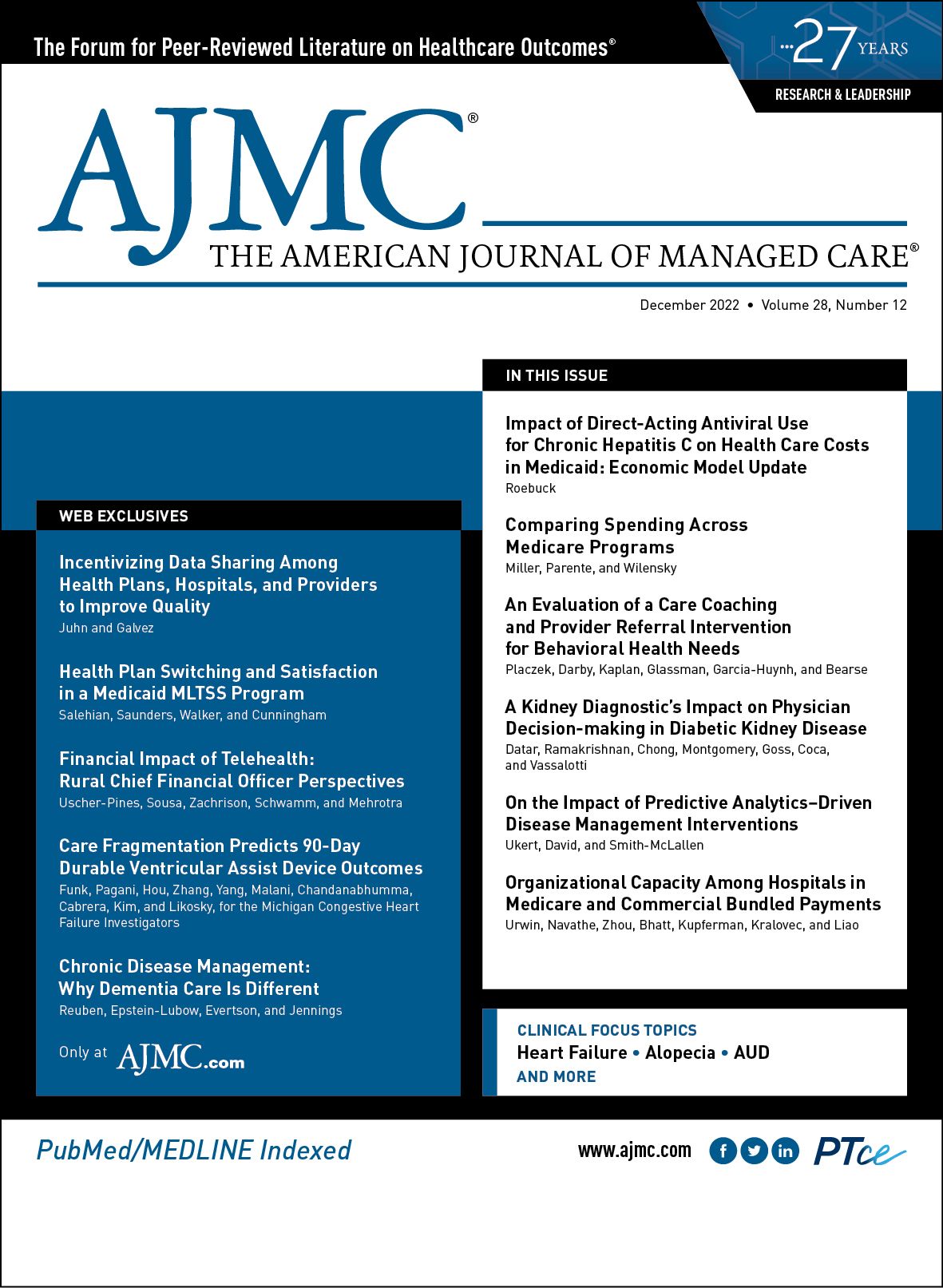Publication
Article
The American Journal of Managed Care
Impact of Direct-Acting Antiviral Use for Chronic Hepatitis C on Health Care Costs in Medicaid: Economic Model Update
Author(s):
Curative direct-acting antivirals for chronic hepatitis C provide a net economic benefit to Medicaid in less than 1 year. Cumulative savings to date have exceeded $15 billion.
Am J Manag Care. 2022;28(12):630-631. https://doi.org/10.37765/ajmc.2022.89273
In our article published in a June 2019 supplement to The American Journal of Managed Care®,1 my coauthor and I estimated the burden of illness of chronic hepatitis C virus (HCV) in Medicaid using claims data from just prior to the introduction of the curative direct-acting antiviral (DAA) medications.2 On average, patients with HCV had annual Medicaid costs that were $17,674 (in 2017 US$) more than those of individuals without HCV. In the second part of our study, we constructed an economic model that combined the HCV burden results with DAA cost and utilization information from 2013-2018 Medicaid State Drug Utilization Data (SDUD).3 Our model considered drug-specific cure rates, treatment duration, and estimated rebates, and it assumed that patients cured by DAAs would have their HCV costs reduced by 90%—a figure derived via our detailed analysis of the health services utilized by HCV-infected individuals. We concluded that DAAs began to “pay for themselves” in Medicaid on a yearly basis in 2017, and cumulatively in 2019. We forecasted that by the end of 2022 DAAs would have saved Medicaid nearly $12.1 billion (in 2017 US$). Given that 3 (atypical) years have elapsed since its publication, an update to the model was warranted.
METHODS
After expanding the DAA drug list to include the authorized generics of ledipasvir/sofosbuvir and sofosbuvir/velpatasvir launched in 2019, I extracted Medicaid SDUD data on all DAA prescriptions filled during the period 2018-2021. I maintained all prior model assumptions including the estimated mean rebate of 53.3% across all DAAs. Based on 2021 SDUD data, this translated to a mean net cost of $5556 per 4-week supply of a DAA, which represents an 80% decrease from the initial price of sofosbuvir in 2013.4 This indicates that a 12-week course of DAA treatment is less costly than a single year of HCV burden. Finally, the COVID-19 pandemic likely reduced DAA utilization, which declined in Medicaid by 24% from 2019 to 2021, a finding reported elsewhere.5 To accommodate an expected rebound, I assumed a 1-time 10% increase in DAA use in Medicaid in 2022. Where noted, monetary values were converted into common dollar years using the historical Consumer Price Index for medical care or 3% per year beyond 2022.6
RESULTS
Tables 1 and 2 present the updated model forecasted through 2026. An estimated 284,580 Medicaid enrollees have been cured of HCV with DAAs from 2013 through 2021. This number is expected to grow to 485,955 by the end of 2026. Net total health care cost savings from DAA use in Medicaid exceeded $5.19 billion in 2022. From 2013 to 2016, annual DAA treatment costs exceeded health care cost savings, but this reversed beginning in 2017. In 2019, cumulative net total health care cost savings turned positive, reaching just over $15 billion in 2022—or $13.2 billion in 2017 US$, which is about 9% higher than predicted by the prior model. The model forecasts that by the end of 2026, DAAs will have generated cumulative net savings to Medicaid in excess of $43 billion.
CONCLUSIONS
The cost of curing chronic HCV using DAAs is now lower than a single year of disease burden in Medicaid. Any remaining access restrictions based on short-run cost-benefit calculations, even for patients with noncirrhotic disease, would seem to be misguided. Moreover, health care cost savings from DAAs accrue to Medicaid year after year, which further strengthens the case for expanded HCV screening and treatment.
Author Affiliation: RxEconomics LLC, Hunt Valley, MD.
Source of Funding: Pharmaceutical Research and Manufacturers of America (PhRMA).
Author Disclosures: Dr Roebuck reports receiving funding for this project from PhRMA.
Authorship Information: Concept and design; acquisition of data; analysis and interpretation of data; drafting of the manuscript; critical revision of the manuscript for important intellectual content; statistical analysis; obtaining funding; administrative, technical, or logistic support; and supervision.
Address Correspondence to: M. Christopher Roebuck, PhD, RxEconomics LLC, 11350 McCormick Rd, Executive Plaza II, Ste 705, Hunt Valley, MD 21031. Email: mcr@rxeconomics.com.
REFERENCES
1. Roebuck MC, Liberman JN. Assessing the burden of illness of chronic hepatitis C and impact of direct-acting antiviral use on healthcare costs in Medicaid. Am J Manag Care. 2019;25(suppl 8):S131-S139.
2. Medicaid Analytic eXtract general information. CMS. Updated December 1, 2021. Accessed May 27, 2022. https://www.cms.gov/Research-Statistics-Data-and-Systems/Computer-Data-and-Systems/MedicaidDataSourcesGenInfo/MAXGeneralInformation.html
3. State drug utilization data. Medicaid. Accessed May 27, 2022.
https://www.medicaid.gov/medicaid/prescription-drugs/state-drug-utilization-data/index.html
4. Silseth S, Shaw H. Analysis of prescription drugs for the treatment of hepatitis C in the United States. Milliman. June 11, 2021. Accessed May 27, 2022. https://www.milliman.com/-/media/milliman/pdfs/2021-articles/6-11-21-analysis-prescription-drugs-treatment-hepatitis-c-us.ashx
5. Shakeri A, Konstantelos N, Chu C, et al. Global utilization trends of direct acting antivirals (DAAs) during the COVID-19 pandemic: a time series analysis. Viruses. 2021;13(7):1314. doi:10.3390/v13071314
6. Consumer Price Index for medical care (all urban consumers). Series ID CUUR0000SAM. Bureau of Labor Statistics. Accessed May 27, 2022.
https://www.bls.gov/cpi/data.htm


Impact of Telemedicine Use on Outpatient-Related CO2 Emissions: Estimate From a National Cohort

The Role of Advanced Technologies in Improving Diabetes Outcomes

Impact of Telemedicine Use on Outpatient-Related CO2 Emissions: Estimate From a National Cohort

The Role of Advanced Technologies in Improving Diabetes Outcomes
2 Commerce Drive
Suite 100
Cranbury, NJ 08512
© 2025 MJH Life Sciences® and AJMC®.
All rights reserved.

